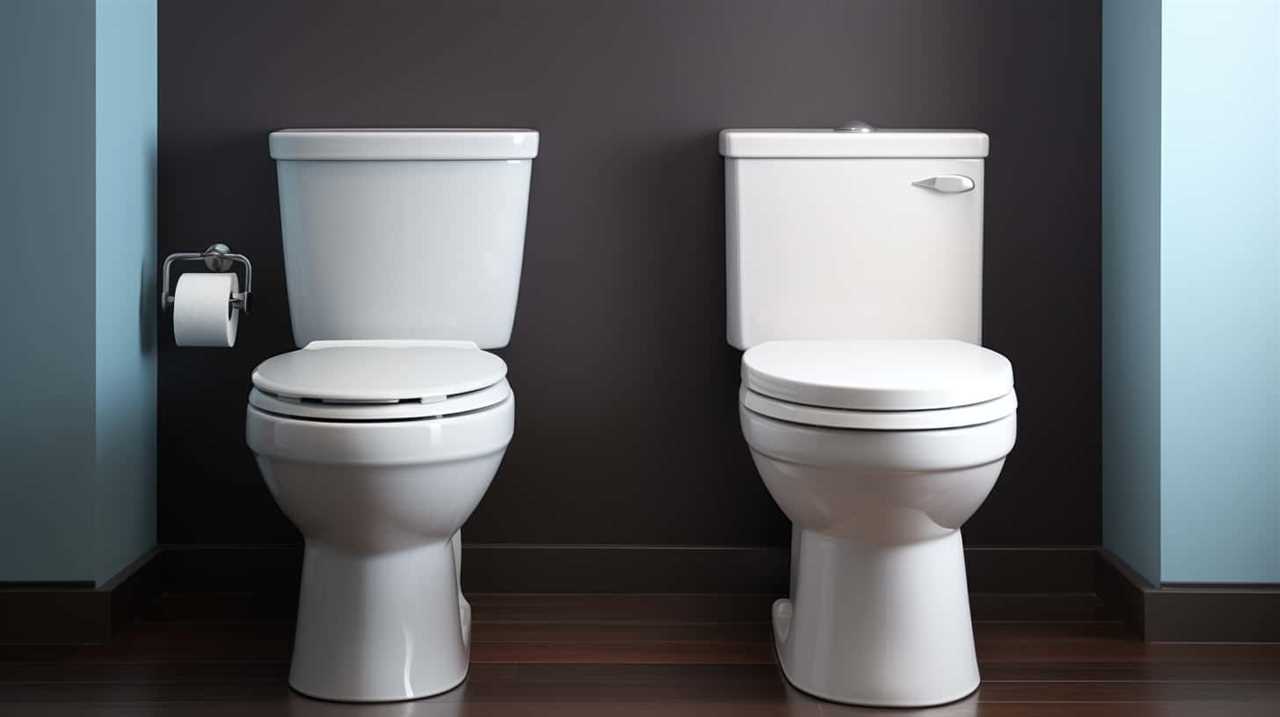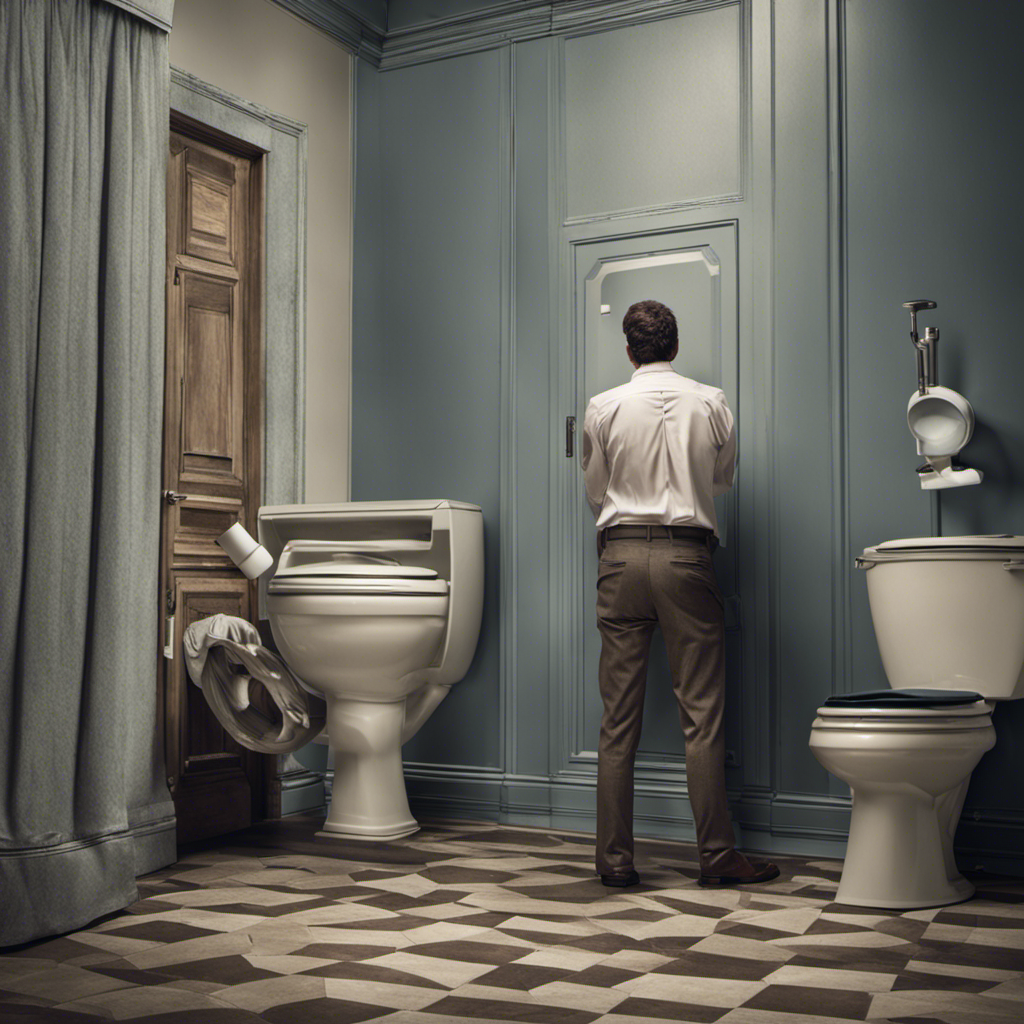Have you ever wondered what happens when we flush an object down the toilet? Well, let us enlighten you.
When we send non-flushable items swirling down the porcelain throne, we risk causing serious damage to our plumbing system. Clogged pipes, disrupted sewage treatment processes, and environmental consequences are just a few of the potential consequences.
Not to mention the hefty costs and repairs that may follow. So, before we impulsively hit that flush button, let’s delve into the world of toilet object disposal and discover the potential havoc we may unleash.
Key Takeaways
- Flushing objects down the toilet can cause significant damage to the plumbing system, including blockages and decreased water pressure.
- Conducting a risk assessment is crucial to understand the potential consequences of flushing objects, with hygiene products and "flushable" wet wipes posing the highest risk of clogging pipes.
- Flushing objects can disrupt the sewage treatment process, leading to the release of untreated or partially treated wastewater and potential water contamination, posing public health risks and increasing strain on the system.
- Flushing objects can have environmental consequences, such as polluting water sources, harming aquatic life, disrupting ecosystems, and affecting habitats of organisms. Responsible waste disposal is essential to avoid these consequences.
Potential Damage to the Plumbing System
What kind of damage can objects flushed down the toilet cause to our plumbing system?

Flushing objects down the toilet can lead to significant damage to our plumbing system, affecting both water pressure and structural integrity. When foreign objects are flushed, they can get stuck in the pipes, causing blockages that restrict the flow of water.
This can result in decreased water pressure throughout the plumbing system, making it difficult for water to reach its intended destinations. Additionally, the force of water pushing against the trapped object can weaken the pipes over time, compromising their structural integrity.
This can lead to leaks, bursts, and costly repairs. It’s crucial to understand that toilets are designed to handle specific waste, and flushing anything other than toilet paper and human waste can have detrimental effects on the plumbing system.
Risk of Clogged Pipes
After objects are flushed down the toilet, the risk of clogged pipes increases significantly. Conducting a risk assessment is crucial to understand the potential consequences and take preventive measures. To illustrate the severity of this issue, let’s consider the following table:

| Object | Risk Assessment | Preventive Measures |
|---|---|---|
| Toilet paper | Low risk of clogging | Use toilet paper that dissolves easily |
| Hygiene products | High risk of clogging | Dispose of them in a proper waste bin |
| Cotton balls | Moderate risk of clogging | Avoid flushing them and throw them in the trash |
| Wet wipes | Very high risk of clogging | Only flush those labeled as "flushable" |
| Small toys | Extremely high risk of clogging | Keep them away from the toilet at all times |
Understanding these risks and implementing preventive measures can help avoid clogged pipes and the subsequent impact on the sewage treatment process.
Impact on the Sewage Treatment Process
To continue the discussion from the previous subtopic, flushing objects down the toilet can have a significant impact on the sewage treatment process. Here are three ways it affects the system:
- Water contamination: When objects are flushed, they can disrupt the normal flow of sewage within the treatment system. This can lead to the release of untreated or partially treated wastewater into water bodies, posing a risk of water contamination.
- Public health risks: Flushing objects down the toilet can introduce harmful substances or bacteria into the sewage treatment process. These contaminants can potentially compromise the quality of the treated water that’s eventually released back into the environment. This poses a risk to public health, as the contaminated water can contaminate drinking water sources or recreational water bodies.
- Increased strain on the system: Flushing objects that aren’t meant to be disposed of through the toilet can cause blockages and damage to the sewage treatment infrastructure. This can result in costly repairs and maintenance, as well as disruptions to the normal functioning of the system.
Environmental Consequences
Flushing objects down the toilet can have detrimental environmental consequences, including polluting water sources and disrupting ecosystems. When objects are flushed, they can end up in water bodies such as rivers, lakes, and oceans, leading to water pollution. The materials from these objects can leach harmful chemicals, such as heavy metals or toxic substances, into the water, contaminating it and potentially harming aquatic life.
Additionally, the presence of foreign objects in the ecosystem can disrupt the natural balance and functioning of the ecosystem. For example, objects may block waterways, obstructing the flow of water and affecting the habitats of various organisms.

These environmental consequences highlight the importance of responsible waste disposal.
Now, let’s explore the potential costs and repairs associated with flushing objects down the toilet.
Potential Costs and Repairs
How much will it cost us to fix the damage caused by flushing objects down the toilet?
The cost of repairing such damage can vary depending on the extent of the problem and the required repairs. In many cases, it’s necessary to seek professional assistance due to the complexity of the repairs.

Here are three potential costs and repairs associated with flushing objects down the toilet:
- Pipe damage: Flushing objects down the toilet can result in clogged or damaged pipes. Repairing or replacing pipes can be a costly endeavor, especially if the damage is extensive.
- Toilet replacement: If an object causes significant damage to the toilet itself, it may need to be replaced entirely. This can be a costly repair that requires professional assistance.
- Water damage: Flushing objects down the toilet can lead to water leaks or floods. Repairing water damage can be expensive, especially if it affects other areas of the property.
Frequently Asked Questions
Can Flushing an Object Down the Toilet Cause Damage to the Bathroom Fixtures, Such as the Toilet Bowl or the Flushing Mechanism?
Flushing objects down the toilet can cause serious damage to bathroom fixtures, such as the toilet bowl and flushing mechanism. This can lead to costly repairs and plumbing emergencies. Proper bathroom maintenance is crucial to avoid these issues.
Is It Possible for a Flushed Object to Get Stuck in the Sewer Line and Block the Flow of Wastewater From the Toilet?
Flushing objects down the toilet poses risks. It’s possible for objects to block the sewer line, causing a backup of wastewater. Prevention is key. Avoid flushing anything besides toilet paper and waste to maintain proper wastewater flow.
Does Flushing an Object Down the Toilet Affect the Efficiency of the Sewage Treatment Process in Any Way?
Flushing an object down the toilet can have negative effects on water quality and potentially cause damage to the sewage treatment plant. It is important to avoid disposing of objects in the toilet to maintain the efficiency of the treatment process.

Are There Any Long-Term Environmental Consequences Associated With Flushing Objects Down the Toilet?
Long-term ecological impact of flushing objects down the toilet can result in potential contamination. It is essential to understand the consequences of such actions to preserve the environment and ensure the efficiency of sewage treatment processes.
How Much Would It Typically Cost to Repair a Toilet and the Plumbing System if an Object Was Flushed Down the Toilet and Caused a Blockage?
The cost of repairing a toilet and the plumbing system after a blockage caused by flushing an object can vary. It depends on the extent of the damage, materials needed, and the labor involved.
Conclusion
In conclusion, flushing objects down the toilet can lead to severe damage to the plumbing system, resulting in clogged pipes and costly repairs.
While some may argue that small objects can easily be flushed without consequences, it’s important to remember that even seemingly harmless items can cause major issues in the sewage treatment process and have detrimental environmental consequences.

Therefore, it’s crucial to dispose of objects properly to avoid these potential risks and ensure the smooth functioning of our plumbing systems.










